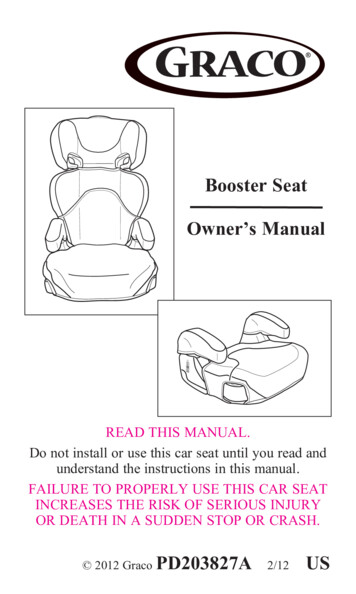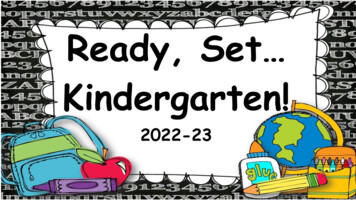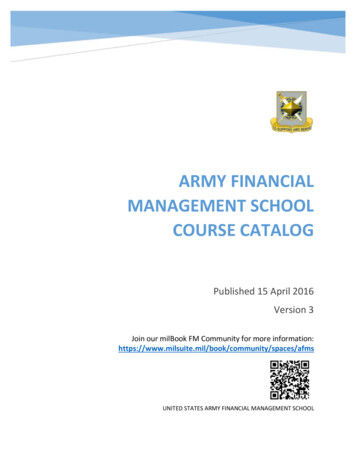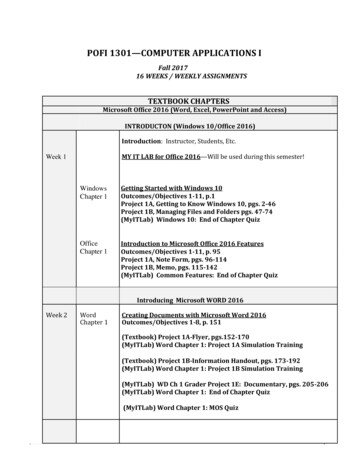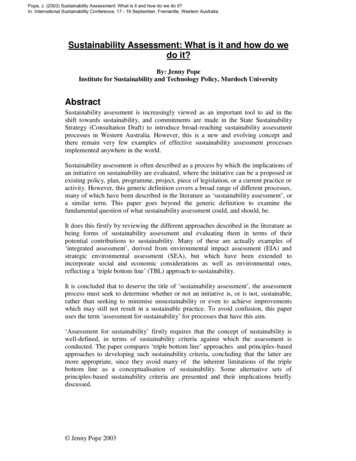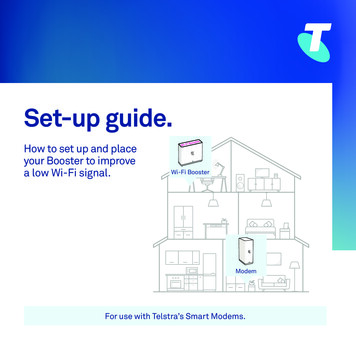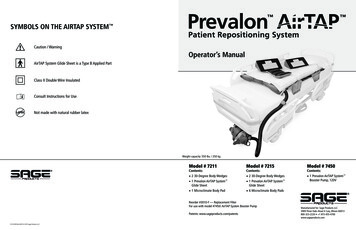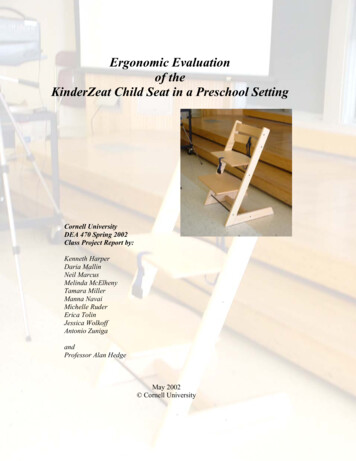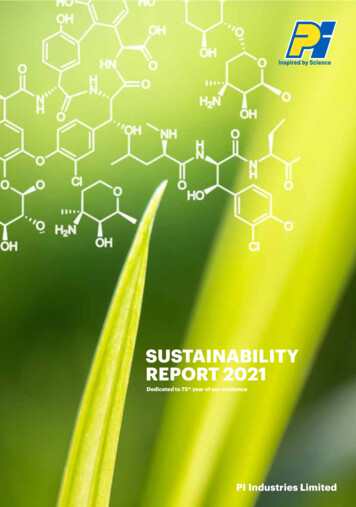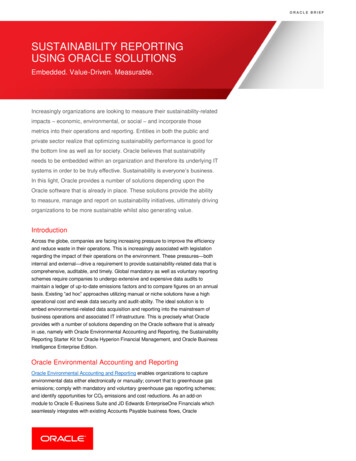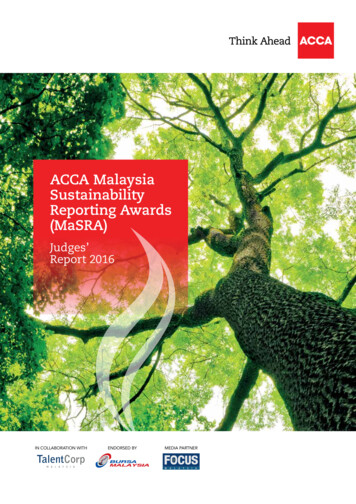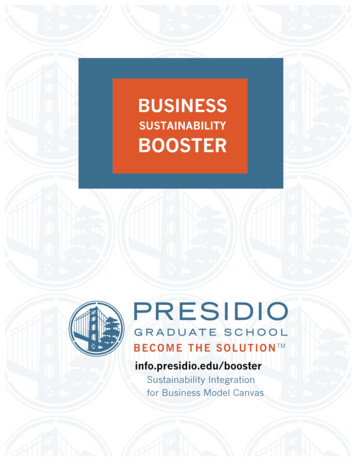
Transcription
sterSustainability Integrationfor Business Model Canvas
Business Sustainability BoosterSustainability Integration for Business Model CanvasOVERVIEW:The Business Sustainability Booster (BSB) helps entrepreneurs and businessstudents integrate sustainable principles into the entire organization. It provides aset of thought-provoking questions which help to identify social and environmentalthreats and opportunities. Those familiar with the Business Model Canvas (BMC)will see that it is built off the same structure however, familiarity with the BMC isnot required.BACKGROUND:The Business Sustainability Booster is intended to supplement the Business ModelCanvas (BMC), which is available for free via Strategyzer.com under the CreativeCommons license and described in detail in the book, Business Model Generationby Alexander Osterwalder and Yves Pigneur. The Business Model Canvas is a toolto help entrepreneurs refine their business concepts, but it is neutral on issues ofcorporate responsibility and sustainability. This Business Sustainability Booster asksquestions that entrepreneurs should consider as they design their business modelsto maximize their benefit to society and the environment.This set of Business Sustainability Booster cards was created by Marsha Willard, CoreFaculty at Presidio Graduate School, and Darcy Hitchcock under the direction of JillBamburg at Presidio Graduate School under a grant from the Lemelson Foundation. Itleverages the Business Model Canvas created by Strategyzer.com which asks that anyderivative work be licensed under the same Creative Commons license.ABOUT PRESIDIO GRADUATE SCHOOL:Presidio Graduate School offers MBA, MPA, and Dual Degrees in Sustainable Management.The school disrupts traditional teaching methods and helps innovative thinkers collaborateand form critical bridges between public and private sectors so they can tackle the world’sgreatest problems as intrepreneurs, entrepreneurs, or public servants.Presidio Graduate School is the sustainability powerhouse of higher education with over1,600 alumni from the combined MBA and MPA programs of sustainable management inSan Francisco, Bainbridge Island, and Seattle. Learn more at presidio.edu.Business Sustainability Booster (BSB)info.presidio.edu/boosterPresidio Graduate School2
How does BSB work?The Business Sustainability Booster consists of a set of 30 cards each of which is linked toone of the nine components of the Business Model Canvas. Each card contains threesections:1. Broad Benefit – a description of the critical sustainability issue related to thebusiness model component2. Why this question is important – the business rationale for why and how this issueis of strategic importance3. Considerations – more detailed questions intended to elucidate the issue and helpan entrepreneur think through the implications for his/her own situationSAMPLE AUDIENCES:The cards are designed for a broad array of entrepreneurs including traditionally-mindedentrepreneurs who may not have considered issues of sustainability as well as socialentrepreneurs or entrepreneurs working in both developed and developing economies. Theselection of cards and their use may vary according to the audience at the discretion ofthe facilitator.Facilitator Tip:Use your judgment about the best way to use the cards for a particular audience orsituation. Consider these recommendations for different audiences.1. Traditional EntrepreneursTraditional entrepreneurs, especially those in the start-up phase, will be focused ontheir core business. Presenting all the cards at once is probably not a good idea asthey may find all the questions an overwhelming distraction. However, you might usethem to: PINPOINT KEY TOPICS:Pull out a few cards that address suspected blind spots, particular risks or threats,and add them to the standard questions in the Business Model Canvas or as part ofa business planning process.INITIATE A ROUTINE EXERCISE:Randomly pull out a card for managers to discuss as a warm up to businessmeetings.PROMOTE TEAM BUILDING:Assign a card to small groups during strategic planning meetings and ask eachgroup to report out any insights or ideas gained from their discussions.Business Sustainability Booster (BSB)info.presidio.edu/boosterPresidio Graduate School3
2. Social Entrepreneursfocused on issues of underdeveloped communitiesThese entrepreneurs are focused on solving a particular issue in their communities(e.g., access to clean water, healthcare, etc.). They are different from traditionalentrepreneurs in that they are trying to ‘do well by doing good.’ These cards may helpthese entrepreneurs avoid unintended negative side-effects. With this group we suggestyou: ELIMINATE ADDRESSED & IRRELEVANT ISSUES:Weed out cards that represent ideas already embedded in their business plan orissues likely inappropriate for their situation because they speak to customersegments in the developed world. EXPLORE IMPACT POTENTIAL:Identify cards that might help the entrepreneur stretch their business concept tohave greater positive impact. For example, if the enterprise is largely social, presentthem cards related to environmental and economic opportunities they might haveoverlooked.3. Social Entrepreneursworking in developed nationsThese entrepreneurs will have similar issues as those working in underdevelopedcommunities, except that the cards that seemed irrelevant for developing countries arelikely the ones that are appropriate for this group. See the bullets above.4. Sustainability-focused Entrepreneurs:These entrepreneurs are like social entrepreneurs except that they may already haveconsidered many of the social and environmental issues presented in the cards. Theywant to use multidisciplinary approaches to solve systems of problems that cross oversocial, environmental and economic issues. These individuals may benefit fromreviewing all the cards. You may want to: USE BSB TO COMPLETE ALL NINE BMC SEGMENTS:Introduce a couple of the cards associated with each of the Business ModelCanvas blocks as they work on each. APPLY BSB AFTER BMC COMPLETION:Or wait until a first draft of the canvas is completed and then break managersinto groups to address a handful of cards each. Then reconvene to see whatrecommendations for change they would suggest.Business Sustainability Booster (BSB)info.presidio.edu/boosterPresidio Graduate School4
5. Business students:Business students should be exposed to all the cards so they understand thebreadth of issues, risks, and opportunities that a sustainability strategy affords. Youmight be able to use the cards to: TEST NEW CONCEPTS:Work through their own business ideas, in conjunction with the traditional BMCquestions. ASSESS REAL SCENARIOS:Analyze case studies. Hand out a handful of cards to teams working on a casestudy and see if they uncover business opportunities that the case examplesmissed. APPLY LEARNED SKILLS:Facilitate the use of the cards in one of the ways described for the otheraudiences above with their own employers, during summer internships, or withproject-based learning opportunities in the community.Business Sustainability Booster (BSB)info.presidio.edu/boosterPresidio Graduate School5
INSTRUCTIONS:We have created this electronic file for your use. You will likely want to print the ‘cards’ orpages out when you use them with clients. Since this is all about sustainability, however,we had some thoughts about how to minimize your environmental footprint: FORTIFY THEM FOR REUSE:Contact Presidio Graduate School at booster@presidio.edu to purchase a laminatedset. Or, if you are likely to use many or most of the cards, you might print the entireset on card stock or laminate them yourself so they can be reused. You can putthem in a binder and pull out only the ones you need. It may help you to print eachcategory of cards on different colored paper stock, which will make them easier toreassemble. However, the pages are numbered. PRINT ONLY WHAT YOU NEED:If you are likely to pick and choose cards, you may want to just print those pagesfor each client and recycle them at the end of the exercise. USE PRINTED CARDS FOR NOTES:Of course, you can print the entire set each time you use this tool which will allowparticipants to make notes on the documents. Please remember to recycle themafterward.SUMMARY OF THE CARDSThe chart below summarizes the sustainability-related questions Business SustainabilityBooster adds to the nine segments of the canvas. There is one ‘card’ for each. Thisadvance organizer may help you determine which cards/questions will be most relevant toyour client. On the following page, we also provide a listing of the Category, Issue andQuestion from each card. This can also help you choose the best questions and find themin the set, but the list also might be useful for your clients to review so they too canidentify intriguing questions they want to explore.Key PartnersKey ActivitiesValue PropositionsBroad BenefitVendors/SuppliersProduct/Service DesignCustomerRelationshipsCustomer SegmentsCompetitorsMindful ImpactHonoring CustomersAccessEmployeesProcessesCustomer BehaviorTransparencyNGO’sFacilitiesBranding SustainabilityEmerging NeedsImportanceCommunitiesGovernment/RegulatorsKey sImpactWaterAccessibilityIndustry TransformationOrganizational StructureEnergyCost StructureRevenue StreamsReturn on investmentSources of revenueExternalitiesDistribution of revenueBusiness Sustainability Booster (BSB)info.presidio.edu/boosterPresidio Graduate School6
CATEGORIES, ISSUES AND PRIMARY QUESTIONSVALUE PROPOSITION . 1Broad Benefit . 1What could be the larger value proposition beyond the immediate customer need we could meet? .1VALUE PROPOSITION . Error! Bookmark not defined.Mindful Impact . 2Does our product inadvertently create new problems or needs in its attempt to solve an existing problemor need? .2VALUE PROPOSITION . 3Customer Behavior . 3How can our product or service help our customers be more sustainable? .3VALUE PROPOSITION . 4Branding Sustainability . 4What sustainability related issues are going to be an important part of our value proposition? Willsustainability be key to our brand?.4CUSTOMER RELATIONSHIPS . 5Honoring Customers. 5How can we best honor our customers for who they are? .5CUSTOMER RELATIONSHIPS . 6Transparency . 6What information would customers want to develop a trusting, honest relationship with us.6CUSTOMER RELATIONSHIPS . 7Emerging Needs . 7How might we stay connected to customers, even after the current commercial relationship has finished,so that we can gain insights to their emerging needs? .7CHANNELS . 8Impacts . 8What are the impacts of our channel choices and how might we mitigate them? .8CHANNELS . 9Accessibility . 9How might we provide channels to make it easier for the underserved to gain access to our product orservice? .9Business Sustainability Booster (BSB)info.presidio.edu/boosterPresidio Graduate School7
CUSTOMER SEGMENTS . 10Access . 10How could we adjust our business model to serve potential customers who have barriers to purchasingour product/service? . 10CUSTOMER SEGMENTS . 11Importance. 11How important is sustainability to each of our customer segments? . 11COST STRUCTURE . 12Return on Investment. 12What is the expected return on investment for pursuing sustainability as a business strategy? . 12COST STRUCTURE . 13Externalities . 13What externalities is our business creating or dependent upon and how can we best manage the risksassociated with them? . 13REVENUE . 14Sources of Revenue . 14What revenue streams could be leveraged so that all who need our product or service could have accessto it? . 14REVENUE . 15Distribution of Revenue . 15What is a fair distribution of revenues to each stakeholder? . 15KEY PARTNERS . 16Competitors . 16How can we use sustainability to differentiate ourselves from our competitors? . 16KEY PARTNERS . 17Owners/Investors/Grantors. 17Who are the primary providers of financial capital for our business and to what degree do they support asustainable business model? . 17KEY PARTNERS . 18Vendors/Suppliers . 18What would we need of our vendors/suppliers to support a sustainability strategy? . 18KEY PARTNERS . 19Employees . 19How could we ensure internal social sustainability for our employees? . 19KEY PARTNERS . 20Communities . 20How do we define 'community' in our context and how could we add value to our community? . 20Business Sustainability Booster (BSB)info.presidio.edu/boosterPresidio Graduate School8
KEY PARTNERS . 21Governments/Regulators . 21Which governmental entities will likely impact our business and are they likely to help or hinder ourefforts to be sustainable? . 21KEY PARTNERS . 22Non-governmental Organizations . 22Which NGO’s might influence our operations and are they likely to help or hinder our efforts to besustainable? . 22KEY PARTNERS . 23Industry Transformation . 23In what ways might we contribute to the transformation of our industry toward sustainability?. 23KEY PARTNERS . 24Organizational Structure . 24How might we structure our organization to maximize benefit to all stakeholders? . 24KEY RESOURCES . 25Materials . 25What are the impacts of the resources that we consume and how vulnerable are they to future pressures?. 25KEY RESOURCES . 26Water . 26To what degree are we dependent on water to the manufacture, delivery or disposal of ourproduct/service and if it is significant, how might we reduce it? . 26KEY RESOURCES . 27Energy . 27To what degree are we dependent on non-renewable energy as an input in the manufacture, delivery ordisposal of our product/service and if it is significant, how might we reduce it? . 27KEY ACTIVITY . 28Product/Service Design . 28In what ways can we design our product or service to be more sustainable? . 28KEY ACTIVITY . 29Processes . 29How can we make our work processes as efficient and sustainable as possible using best availabletechnologies? . 29KEY ACTIVITY . 30Facilities . 30How can we minimize the footprint will our operations require? . 30Business Sustainability Booster (BSB)info.presidio.edu/boosterPresidio Graduate School9
VALUE PROPOSITIONBroad BenefitWhat could be the larger valueproposition beyond theimmediate customer need wecould meet?Considerations How might our product or service further enhancethe quality of life (e.g. health, safety, accessibility,education) of our customers beyond its immediatebenefit? How might we refine the business model tocontribute even more to their ability to thrive? Are there opportunities for our product/service tocontribute to the solution of larger social orenvironmental problems beyond its primarypurpose? In what way does promoting these multiple benefitsimprove our brand?Notes:Why this question is importantPrimarily your purpose is to meet a customer need, butconscious companies understand the full impacts of theproducts or services they introduce into society. Taking asystems thinking approach may allow for the discovery ofother positive, unintended benefits that enhance the valueproposition of an offering, expand markets and makepositive contributions to the world. Following the growingtrend among consumers who expect business to do morethan just make a profit, this examination of multiplepotential benefits also helps build a more widely acceptedbrand image.Business Sustainability Booster (BSB)Presidio Graduate School info.presidio.edu/booster1
VALUE PROPOSITIONMindful ImpactDoes our product inadvertentlycreate new problems or needsin its attempt to solve anexisting problem or need?Considerations Does our product or service potentially create anynew problems for the customer? What are the fullimpacts beyond the intended one? How might wemitigate them? Does our product or service create any newproblems in society or the environment? How mightwe mitigate them?Notes:Why this question is importantPresumably any product or service brought to market isattempting to meet a need or solve a consumer problem.Sometimes, however, products that meet one customerneed, may inadvertently create another problem in theprocess. Food products, for example, that satisfyconsumers’ tastes sometimes contribute to healthproblems like obesity and high blood pressure. Otherproducts manufacture needs that may not really exist,creating unnecessary expenses for unsuspectingconsumers who may not be able to afford them. Thesenegative side effects can tarnish brand image when theycome to the attention of the media, the public, regulatorsand/or customers.Business Sustainability Booster (BSB)Presidio Graduate School info.presidio.edu/booster2
VALUE PROPOSITIONCustomer BehaviorHow can our product or servicehelp our customers be moresustainable?Why this question is importantFor many products or services the biggest impact is in howtheir consumers use them or behave in the process ofusing them. Insurance companies, for example, typicallyhave a low environmental footprint in their operations, butcan have a huge impact in how their customers behavethrough the design of their policies. They can influencehow much or what people drive, where and how they live,and how healthy their life styles are just through policydesign.Companies have an enormous opportunity to encouragemore sustainable behavior in their customers by the waythey design or shape their offerings. This in turn creates agrowing demand for sustainable products and services. Ascustomers’ behavior change, their interest in similarsustainable behavior increases. This “virtuous cycle” movesthe world in a more sustainable direction and buildsmarket opportunities at the same time. Renewable energy,for example, is the fastest growing sector in energy in theUS; the same is true for organic food.Business Sustainability Booster (BSB)Considerations What are the negative impacts associated with usingour product/service? How are our products/servicesactually used or consumed? How much water,energy or other materials will get consumed whencustomers use them? How might we reduce theseimpacts? What are the negative impacts associated withdisposal of our product? What are the options ourcustomers have for disposing of our product at theend of its life? Are we creating a waste disposalproblem? Can we design our product/service to bepart of a 'circular economy’ where all waste streamsbecome resources? What positive customer behavior changes does theuse of
Bamburg at Presidio Graduate School under a grant from the Lemelson Foundation. It leverages the Business Model Canvas created by Strategyzer.com which asks that any derivative work be licensed under the same Creative Commons license. ABOUT PRESIDIO GRADUATE SCHOOL: Presidio Graduate School offers MBA, MPA, and Dual Degrees in Sustainable .
